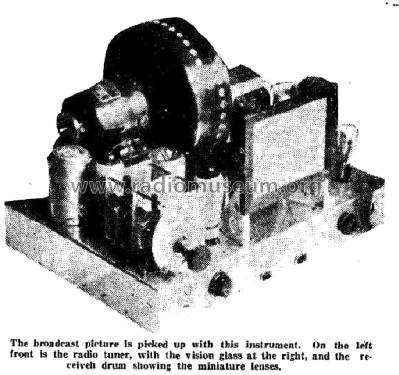Televisor Receiver
Bell’s Inventions Ltd.; Perth, WA
- Paese
- Australia
- Produttore / Marca
- Bell’s Inventions Ltd.; Perth, WA
- Anno
- 1932
- Categoria
- Televisore (TV) / Monitor
- Radiomuseum.org ID
- 317179
- Principio generale
- Ricevitori speciali
- Tensioni di funzionamento
- Alimentazione a corrente alternata (CA) / 250 Volt
- Materiali
- Mobile di metallo, valvole visibili
- Radiomuseum.org
- Modello: Televisor Receiver - Bell’s Inventions Ltd.; Perth,
- Annotazioni
-
Description of the protype, projection,Televisor Receiver:
Special Lamp Used The television receiver is slightly less bulky than the camera, and in most cases could be made to fit at the bottom of the standard radio console. The incoming radio wave bearing the image in electrical form is received on an aerial in the way of the ordinary radio and is passed through one stage of radio frequency and then through a super-efficient screen-grid detector. Theoretically it is an ordinary radio receiver, although there have been some departures from standard practice to meet the un-usual requirements of television. The impulses are passed through a 10 Watt amplifier and conveyed from the plate of the output valve to the special tele-vision lamp made by the Leipsig firm to Mr. Bell's specification, and which, according to the makers, can handle frequencies up to one million cycles a second. The scanning drum of the receiver is of the same size and diameter as the televisor camera drum, but instead of having tiny holes perforated in the metal, there are tiny lenses of about three eighths of an inch diameter, let into the peripherical band of the drum, which, in appearance is not unlike the brake-drum of a motor car. There are the same number of lenses in the receiver as there are pinpricks in the camera-drum, and the incoming electrical impulse, after being passed through the radio receiver and power amplifier, is transferred to the "spot" lamp, which is placed inside the rotating' drum. The light liberated by the lamp is passed through the lenses of the spinning drum on to the ground-glass screen, which is Mr. Bell's present model is seven inches by six in size, but shortly may be 12 inches by 10. By an adjustment of the "spot" lamp within the drum, it is possible, he says, to throw an image on to a screen six feet square at a distance of eight feet from the receiver.
All the apparatus works off the ordinary alternating current mains such as are used by householders, and Bell is satisfied that with one or two minor improvements he will be able to claim the attention of the scientific world.
from The Daily News (WA) August 25, 1932, Page 6.
Text sourced from Trove – National Library of Australia
- Bibliografia
- -- Original prospect or advert (The Daily News (WA) August 25, 1932, Page 6.)
- Autore
- Modello inviato da Gary Cowans. Utilizzare "Proponi modifica" per inviare ulteriori dati.
- Altri modelli
-
In questo link sono elencati 2 modelli, di cui 2 con immagini e 0 con schemi.
Elenco delle radio e altri apparecchi della Bell’s Inventions Ltd.; Perth, WA
